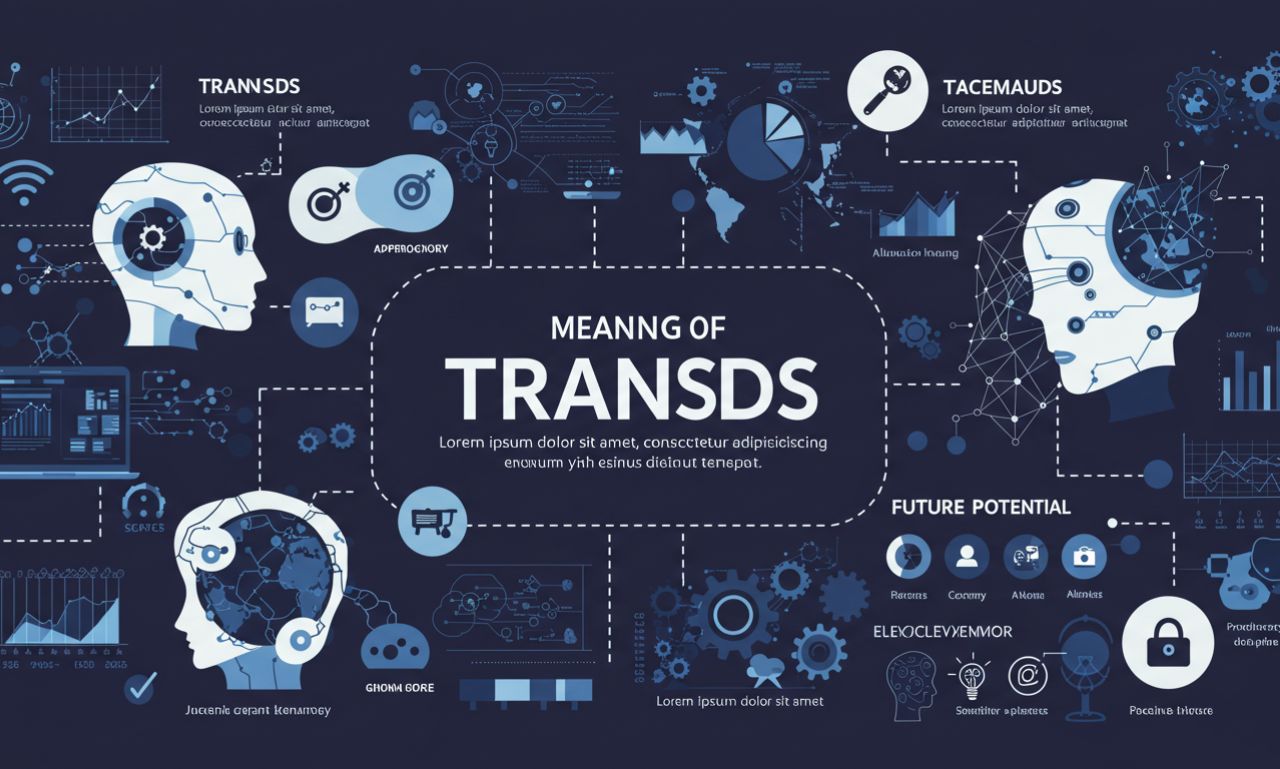Transds is a word that sparks curiosity. At first glance, it feels like a mix of technology, transformation, and adaptability all rolled into one. While not yet a household name, Transds is becoming a concept tied to change management, digital growth, and sustainable innovation. Businesses, schools, and even individuals are exploring it as a framework to handle transitions more smoothly.
Think of it as a guide that helps people and systems move from one stage to another without losing efficiency or momentum. With the world shifting at lightning speed, the ability to adapt quickly is more valuable than ever. This is where Transds steps in, offering tools and approaches that simplify complexity while encouraging innovation and balance.
What is Transds
At its core, Transds refers to a structured approach to transition and adaptability. It combines ideas of transformation, problem-solving, and scalability. The meaning can change slightly depending on context. In business, it might involve improving workflow or managing organizational changes. In technology, it could point toward digital platforms that simplify data transfer or automation.
On a personal level, Transds can even be seen as a way to adapt to career shifts or lifestyle changes. The essence is the same: making transitions smoother and solutions more sustainable. It focuses on efficiency, accessibility, and flexibility, so it can be applied in small or large settings. That makes it less of a single tool and more of a versatile mindset or framework.
Core Features of Transds
Transds is built around a few key principles that make it stand out. It is transition-oriented, meaning it helps people and organizations handle changes with less disruption. It is efficiency-driven, aiming to save both time and resources. Scalability is another feature, allowing it to work for small projects or large companies.
User-centered design is part of its DNA, so it values simplicity and accessibility over complexity. Finally, Transds is innovative at heart, encouraging new approaches to evolving challenges rather than relying on outdated methods. Put together, these features give it the adaptability to remain useful across industries, whether in digital transformation or personal development.
Why Transds Matters
The pace of change in modern industries has never been higher. Companies launch new technologies daily, consumer expectations evolve, and career paths shift faster than ever. Without a clear system, these transitions can feel overwhelming. Transds matters because it provides a structure for navigating this uncertainty. It can help businesses stay competitive while reducing costs, and it enables individuals to handle personal transitions with confidence.
For example, a growing company could adopt Transds principles to manage team expansions without losing productivity. Similarly, a student adapting to online learning could use it to build smoother study routines. In both cases, Transds acts like a compass, keeping people focused and efficient during change. That ability to simplify complexity is exactly what makes it valuable.
Applications of Transds
Transds in Business
Companies survive by adapting to shifting markets. Transds supports this by offering strategies for change management and workflow optimization. For example, when a retail chain adopts new e-commerce platforms, the transition often disrupts operations. With a Transds-inspired approach, this process can become smoother for both employees and customers.
Beyond technology shifts, businesses can use it to improve customer service upgrades, restructure teams, or even manage downsizing with less stress. It is not just about efficiency but also about creating a culture where change feels natural rather than disruptive. This is what makes Transds appealing for organizations looking to stay resilient in unpredictable markets.
Transds in Technology
Technology is where Transds finds some of its most powerful applications. Migrating data, integrating systems, and automating tasks often create headaches for businesses. Transds offers a way to structure these transitions to minimize errors and downtime. For example, a startup moving from a legacy database to a cloud-based platform could rely on Transds frameworks to avoid interruptions.
The approach also supports automation by identifying repetitive tasks and streamlining them. As technology grows more complex, connecting different tools into unified systems is crucial. Transds helps with this integration, ensuring smoother performance and fewer compatibility issues. In short, it keeps technology transitions efficient and less risky.
Transds in Education
The education sector has gone through massive changes with the rise of digital learning. Here, Transds proves useful for building smoother transitions between physical classrooms and online platforms. Schools and universities can use it to develop hybrid models that work for both teachers and students.
For example, a university adopting digital resources can apply Transds strategies to train staff while keeping students engaged. It also applies to research tools, helping scholars adapt to more efficient, technology-driven methods. Beyond infrastructure, it encourages flexibility in teaching, making learning more student-centered. In this way, Transds supports education systems in staying relevant and effective in a rapidly changing world.
Transds in Personal Life
Adaptability is not just a business or tech concern. Individuals also face transitions that can feel overwhelming. Transds can be applied to personal situations like career changes, time management, or even balancing work and family life. For instance, someone shifting from a corporate role to freelancing could use Trends-inspired steps to manage the change without burning out.
It could involve retraining, restructuring daily routines, and building new habits. Similarly, a person handling major life changes such as relocation or parenting could use its principles to create smoother transitions. The personal application of Transds shows that it is more than just a technical framework; it is also a mindset for resilience and growth.
Benefits of Transds
The benefits of Transds are both practical and forward-looking. It saves time by minimizing disruption during changes, which directly impacts productivity. It is cost-effective, as it reduces waste and helps avoid costly mistakes during transitions. Flexibility is another advantage, since it adapts easily to different industries and personal needs. Reliability matters too, because consistent results build trust in the process.
Finally, it is future-ready. Its design encourages innovation and continuous growth, making it suitable for evolving industries. These benefits combine to show why Transds is not just a passing concept but a valuable tool for anyone dealing with transitions. It offers a structured yet flexible path to progress.
Challenges and Limitations of Transds
Like any framework, Transds is not free of challenges. Its biggest hurdle is awareness, since many people and businesses are still unfamiliar with it. Resistance to change also slows adoption, as some organizations prefer sticking with outdated systems. Another challenge is the training required.
Teams may need to learn new skills or methods before they can use Transds effectively. Implementation costs can also be a barrier, particularly for smaller organizations with limited budgets. While these challenges are real, they are not insurmountable. With proper planning, education, and gradual adoption, Transds can overcome resistance and prove its long-term value. The key is showing results that justify the investment.
Case Examples of Transds in Action
One interesting example comes from a financial services firm that needed to transition to cloud-based systems. Initially, the project caused delays and frustration. After adopting Transds strategies, the transition became smoother, and customer data was more secure. In education, a high school introduced e-learning systems after the pandemic.
With Transds-inspired methods, teachers adjusted quickly, and students adapted without losing engagement. On a personal level, a marketing professional shared her story of shifting careers into technology. By breaking the transition into manageable steps, inspired by Transds principles, she retrained effectively and avoided burnout. These stories highlight the practical power of Transds, turning overwhelming transitions into manageable journeys.
The Future of Transds
Looking ahead, Transds is set to become even more relevant. The integration of artificial intelligence will make it smarter, automating transitions more effectively. Global adoption is likely as businesses and individuals worldwide seek structured ways to handle change. Sustainability is another area where Transds will shine, helping companies transition toward eco-friendly practices.
On a personal level, it will continue to support career growth and life balance as people adapt to new challenges. The future of Transds is tied closely to digitalization, automation, and sustainable living. This makes it more than just a current trend. It is shaping up to be a long-term framework for growth, adaptability, and innovation.
SEO and Digital Relevance of Transds
From a marketing perspective, Transds holds strong SEO potential. Since the keyword is unique and not widely used, it offers opportunities to rank content with less competition. Content creators can build topical clusters around it, covering related areas such as digital transformation, adaptability frameworks, and change management systems.
For businesses, this means a chance to establish authority in a niche topic before it becomes mainstream. For bloggers, it is a way to attract targeted traffic interested in innovation and adaptability. When combined with semantic SEO techniques, articles about Transds can position websites as leaders in the conversation around digital and personal transformation.
Conclusion
Transds is more than a buzzword. It is a framework for handling transitions with efficiency, flexibility, and innovation. Its applications in business, technology, education, and personal life make it versatile and valuable. The benefits are clear, from saving time and money to encouraging sustainable growth. While challenges like awareness and resistance remain, the potential for global adoption is undeniable.
Whether used by companies shifting systems, schools adapting to new teaching models, or individuals managing career changes, Transds has the power to make transitions smoother and more effective. Embracing it today could provide the edge needed to stay ahead tomorrow.
Also Read About: Acamento: The Finishing Touch That Transforms Everything
FAQs about Transds
What does Transds mean?
Transds refers to a framework or mindset that focuses on smooth transitions, adaptability, and efficiency across different industries and personal life situations.
How is Transds used in business?
In business, Transds supports change management, workflow optimization, and customer experience improvements, making transitions less disruptive.
Can Transds be applied to personal life?
Yes, individuals can apply Transds principles to handle career changes, time management, or work-life balance more effectively.
What are the key benefits of Transds?
It saves time, reduces costs, adapts across industries, delivers consistent results, and is built for future growth and innovation.
What is the future of Transds?
The future lies in AI integration, sustainability-focused transitions, global adoption, and continued use in personal development and digital transformation.

